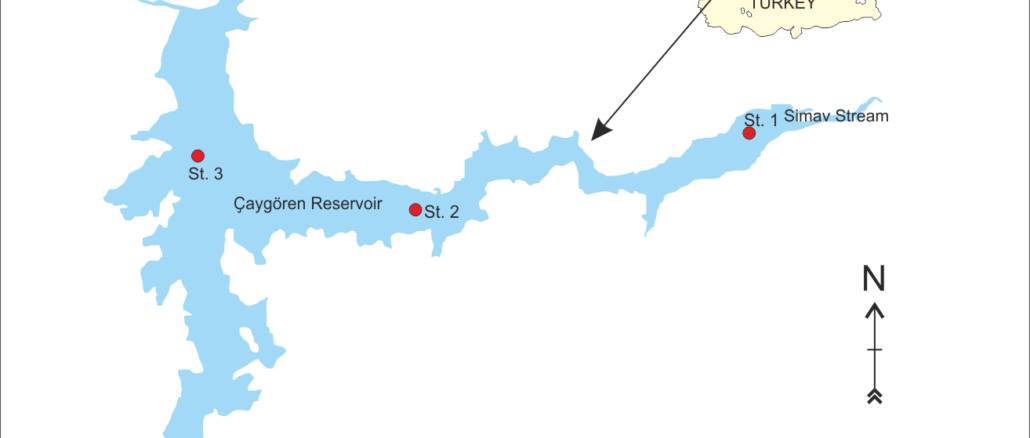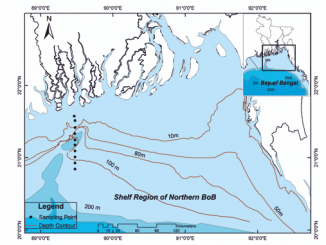
Paper category: Original research paper
Corresponding author: Kemal Çelik (kcelik@balikesir.edu.tr)
DOI: 10.1515/ohs-2018-0001
Received: 2017-07-27
Accepted: 2017-09-04
Full text: here
Citation (APA style):
Abstract
Relationships between chlorophyll-a (chl-a) concentrations and 16 physicochemical variables in temperate eutrophic Çaygören and mesotrophic Ikizcetepeler reservoirs (Turkey) were determined using Principal Component Analysis (PCA). PCA was used to simplify the complexity of relationships between water quality variables. Principal component scores (PCs) were used as independent variables in the multiple linear regression analysis (MLR) to predict chl-a in both reservoirs. This procedure is called Principal Component Regression (PCR). In the eutrophic Çaygören Reservoir, chl-a was significantly (p < 0.05) correlated with nitrite-nitrogen (NO2), ammonium-nitrogen (NH4), phosphate (PO4), total suspended solids (TSS), pH, Secchi disk transparency, total dissolved solids (TDS) and total phosphorus (TP). In the mesotrophic Ikizcetepeler Reservoir, chl-a was significantly (p < 0.05) correlated with TSS, NO2, chemical oxygen demand (COD), sulfate (SO4), TDS, pH and the Secchi disk. In the eutrophic Çaygören Reservoir, six PCs explained 71% of the total variation in the water quality, while in the mesotrophic Ikizcetepeler Reservoir, six PCs explained 75% of the variation. This study has shown that PCR is a more robust tool than direct MLR to simplify the relationships between water quality variables and to predict chl-a concentrations in temperate reservoirs with different trophic states.
References
Anita, B. & Pooja, D. (2013). Water quality guidelines for the management of pond fish culture. Int. J. Environ Sci. 3: 1980–2009. DOI: 10.6088/ijes.2013030600019.
APHA. (1995). Standard Methods for the Examination of Water and Wastewater (19th ed.). Washington, DC: American Public Health Association.
Arar, E.J. (1997). Determination of chlorophylls a and b and identification of other pigments of interest in marine and reshwater algae using high performance liquid chromatography with visible wavelength detection. Method 447. Washington, DC: U.S. Environmental Protection Agency.
Arslan, F. & Ergül, M. (2014). Agricultural activities in the Çaygören Dam Irrigation Area and Sourounding. JASSS 2(1): 171–190. (In Turkish). Retrieved from: http://www.asosjournal.com/DergiTamDetay.aspx?ID=63&Detay=Ozet
Chang, N.B., Yang, Y.J., Daranpob, A., Jin, K.R. & James, T. (2012). Spatiotemporal pattern validation of chlorophyll-a concentrations in Lake Okeechobee, Florida, using a comparative MODIS image mining approach. Int. J. Remote. Sens. 33: 2233–2260. DOI: 10.1080/01431161.2011.608089.
Çamdevirena, H., Demir, N., Kanika, A. & Keskin, S. (2005). Use of principal component scores in multiple linear regression models for prediction of Chlorophyll-a in reservoirs. Ecol. Model. 181: 581–589. DOI: 10.1016/j.ecolmodel.2004.06.043.
Hakanson, L., Malmaeus, J. M., Bodemer U. & Gerhardt, V. (2003). Coefficients of variation for chlorophyll, green algae, diatoms, cryptophytes and blue-greens in rivers as a basis for predictive modeling and aquatic management. Ecol. Model. 169: 179–196. DOI: 10.1016/S0304-3800(03)00269-2.
Huszar, V.L., Caraco, N.F., Roland, F. & Cole, J. (2006). Nutrient-chlorophyll relationships in tropical-subtropical lakes: do temperate models fit? Biogeochemistry 79: 239–250. DOI: 10.1007/s10533-006-9007-9.
Jeppesen, E., Jensen, J. P., Søndergaard, M., Fenger-Grøn, M., Bramm, M.E. et al. (2015). Empirical evaluation of the conceptual model underpinning a regional aquatic long-term monitoring program using causal modeling. Ecol. Indic. 50: 8–23. DOI: 10.1016/j.ecolind.2014.10.011.
Johnson R.A. & Wichern, D.W. (1982). Applied Multivariate Statistical Analysis. Englewood Cliffs: Prentice-Hall Inc.
Karlsson, J., Byström, P., Ask, J., Ask, P., Persson, L. et al. (2009). Light limitation of nutrient-poor lake ecosystems. Nature 460: 506–509. DOI: 10.1038/nature08179.
Köklü, R., Sengörür, B. & Topal, B. (2010). Water Quality Assessment Using Multivariate Statistical Methods-A Case Study: Melen River System (Turkey). Water. Resour. Manag. 24: 959–978. DOI: 10.1007/s11269-009-9481-7.
Møller, P.H. & Rasmussen, H.U. (2004). Impact of fish predation on cladoceran body weight distribution and zooplankton grazing in lakes during winter. Freshwater. Biol. 49: 432–447. DOI: 10.1111/j.1365-2427.2004.01199.x.
Najar, I.A. & Khan, A.B. (2012). Assessment of water quality and identification of pollution sources of three lakes in Kashmir, India, using multivariate analysis. Environ. Earth. Sci. 66: 2367–2378. DOI: 10.1007/s12665-011-1458-1.
Okkan, U. & Karakan, E. (2016). Modeling the Effects of Climate Change on Ikizcetepeler Inflows: 2015–2030 Projection. IMO Teknik Dergi 450: 7379–7401. (In Turkish). Retrieved from http://dergipark.gov.tr/tekderg/issue/28138/299000
Phillips, G., Pietilainen O.P., Carvalho, L., Solimini, A., Solheim, A.L. et al. (2008). Chlorophyll-nutrient relationships of different lake types using a large European dataset. Aquat. Ecol. 42: 213–226. DOI: 10.1007/s10452-008-9180-0.
Praveena, S.M., Kwan, O.I. & Aris, A.Z. (2011). Effects of data pre-treatment procedures on principal component analysis: a case study for mangrove surface sediment datasets. Environ. Monit. Assess. 184: 6855–6868. DOI: 10.1007/s10661-011-2463-2.
Schindler, D. (2012). The dilemma of controlling cultural eutrophication of lakes. Proc. R. Soc. Lond. B. Biol. Sci. 7: 4322–4332. DOI: 10.1098/rspb.2012.1032.
State Water Works. (2017). Çaygören Barajı (In Turkish). http://www2.dsi.gov.tr/baraj/detay.cfm?BarajID=32
Stevens, J. (1986). Applied Multivariate Statistics for the Social Science. New Jersey: Hillsdale.
Steyerberg, E.W., Harrell, F.E. & Habbema, J.D. (2001). Prognostic modeling with logistic regression analysis: in search of a sensible strategy in small data sets. Med. Decis. Making 21: 45–56. DOI: 10.1177/0272989X0102100106.
Zhang, W., Lou, I.C., Kong, Y., Ung, W.K. & Mok, M. (2013). Eutrophication analysis and principal component regression for two subtropical storage reservoirs in Macau. Desalin. Water. Treat. 51: 7331–7340. DOI: 10.1080/19443994.2013.793921.


Bądź pierwszy, który skomentuje ten wpis